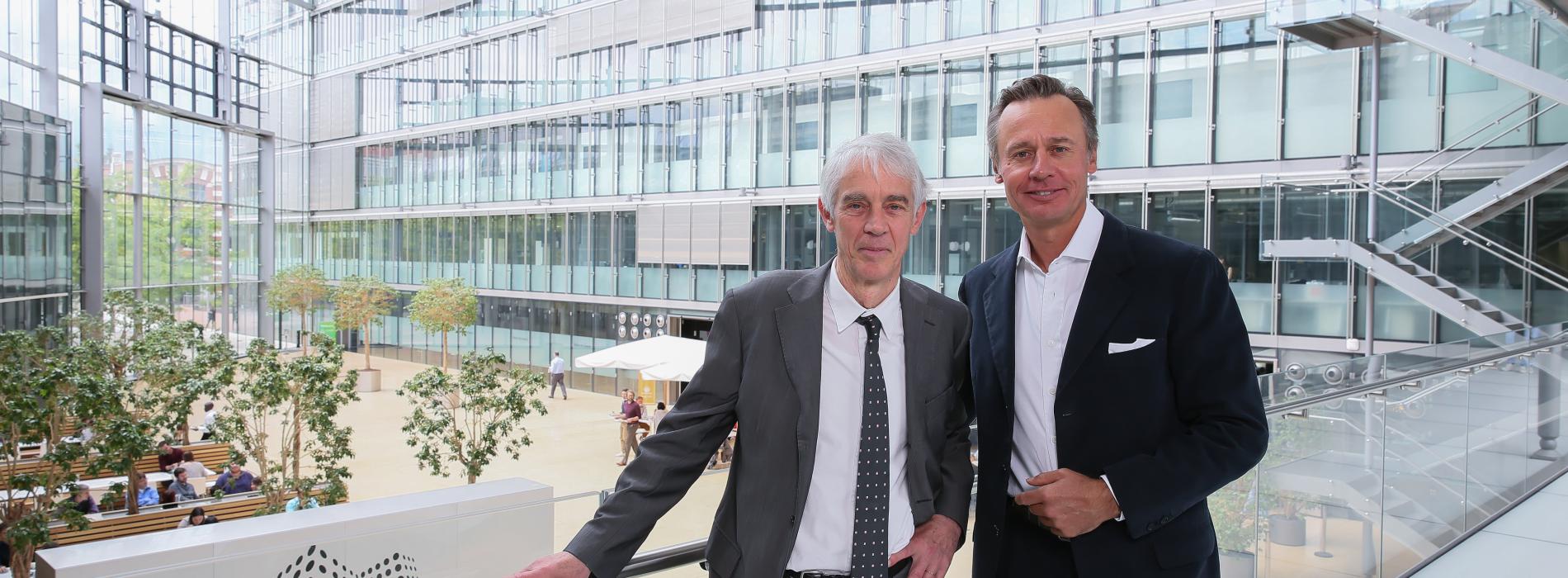
 News
News
Five proposals win initial “catalyst” funding at Campus Biotech
Researchers from Campus Biotech were invited to develop joint projects with partner research institutes and bid for funding from the Bertarelli Foundation. The laureates have been announced, on April 11th, during the 2018 Bertarelli Symposium held at Harvard Medical School.
Less than a year ago, Martin Vetterli and Ernesto Bertarelli announced the launch of the Catalyst Fund @ Campus Biotech. The aim of this five-million-Swiss Franc fund is to promote and accelerate translational research projects on the nervous system in which one or more teams from Campus Biotech (in Geneva) join forces with partner research institutes. The first call for proposals is now complete, and five projects have been selected for funding. “The proposals were of a remarkably high calibre,” says Patrick Aebischer, who chaired the selection committee.
Ernesto Bertarelli adds: “We are delighted to provide funding for these projects. They each represent the vision of innovation and collaboration which led us to create Campus Biotech and make it the home of such partnerships between scientists and institutes in the region. Our congratulations to the recipients of this first round of grants and their shared aim of achieving transformative results for patients. We look forward to following the progress of their research.”
Each of the five projects will receive 300,000 francs, which will be used to kick start their research and which will aim to ensure that the results can be turned into clinical applications.
Optogenetic therapy to restore eyesight
The project proposed by Bernard Schneider (EPFL’s Brain Mind Institute) and Sonja Kleinlogel (University of Bern) aims to bring a method of vision restoration to the stage of clinical trials. One in 300 people is visually impaired owing to a loss of light-sensitive retinal photoreceptors, manifesting in pathologies such as age-related macular degeneration or retinitis pigmentosa. Sonja Kleinlogel’s novel optogenetic gene therapy works by introducing and stimulating synthetic protein into remaining retinal interneurons, turning these cells into “replacement photoreceptors” and ultimately restoring the patient’s natural vision. This therapy has already been tested in the lab but still lacks a viral vector adapted for humans that will guide the novel light-sensing protein efficiently to the right retinal cells.
Treating vision problems after a stroke
Motor and language impairment are common deficits after stroke, yet 30% of victims suffer from vision problems such as loss of parts of the visual field (hemianopia). The project headed by Friedhelm Hummel and involving four colleagues from EPFL, HUG, Hôpital du Valais and the Clinique Romande de Réadaptation (Sion) will use a multimodal approach by functional magnetic resonance imaging (fMRI) and transcranial magnetic stimulation (TMS) simultaneously to map out activity in the visual system following a stroke to better understand the mechanisms of recovery. This will form the basis for rehabilitation strategies involving non-invasive brain stimulation and visual training. The third phase of the project is dedicated to determine potential biological markers allowing to predict individual treatment effects. This will pave the way for patient-tailored targeted therapies towards personalized medicine.
Treating hallucinations in Parkinson’s patients
More than half of people suffering from Parkinson’s disease experience hallucinations – a feeling of presence is one of the most common forms. The neurological processes at play have been studied in Olaf Blanke and Dimitri Van De Ville’s labs at EPFL and can now be triggered using robotic tools. By teaming up with Paul Krack (Geneva University Hospital), the researchers will be able to go further in exploring these processes in patients suffering from Parkinson’s. Their first objective will be to detect the bio-markers associated with these hallucinatory states and then develop non-pharmacological and non-invasive therapeutic approaches based on neurofeedback to counteract them. Their results may one day be applied to hallucinations linked to schizophrenia and other neurodegenerative diseases.
Restoring fine motor skills
A cervical spinal cord injury can lead to partial or total paralysis of the legs, arms and hands. Electrical stimulation applied to nerve fibers below the lesion has already proven effective at restoring leg movement and function. But this method will need to be significantly refined before it can enable patients to recover sufficient motor skills in their hands to carry out day-to-day tasks. Tomislav Milekovic (University of Geneva) and Marco Capogrosso (University of Fribourg) plan to carefully map out both healthy and damaged neural networks in an effort to identify the sections involved in controlling the hands. These signals could subsequently control the electrical stimulation delivered by an implant placed on the spinal cord below the injury.
Controlling the paths of pain
Nearly 20% of the population suffer from chronic pain. Yet such pain is still poorly understood and in many cases cannot be treated with drugs over the long term owing to side effects. Stéphanie Lacour (EPFL) and Isabelle Décosterd (Lausanne University Hospital – CHUV and FBM-University of Lausanne) focus on the hyperexcitability of pain nociceptive neurons and the ion channels that activate them. They are developing the tools needed to create a mechanistic model that could lead to innovative therapies – involving gene therapies, optogenetics and neurotechnologies. One of their goals is to develop an optoelectronic implant that can be applied to the sciatic nerve of mice, along with a platform for optical control and signal detection.